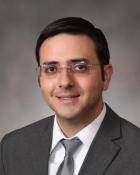Ventricular tachycardia is a type of rapid heartbeat that can be dangerous. There are several types of tachycardias, which are abnormally high heart rates (also called arrhythmias) of more than 100 beats per minute. For Kentuckians with this condition, the UK Gill Heart & Vascular Institute can treat ventricular tachycardia, along with underlying heart disease that may be causing it.
Ventricular tachycardia, also called VT, starts in your heart’s lower chambers, the ventricles. Ventricular tachycardia is defined as when your heart beats in an abnormal rhythm at a rapid pace for at least three consecutive heartbeats.
Most heartbeats start in the sinus node, your heart’s natural pacemaker. The sinus node is in the upper right heart chamber, the right atrium. But sometimes heartbeats start in the ventricles. When these electrical signals misfire, it disrupts your heart’s rhythm. Ventricular arrhythmias prevent blood from filling the heart during beats, which affects blood flow to the brain and throughout the body.
In an otherwise normal heart, brief episodes of ventricular tachycardia, lasting only a few seconds, can be harmless. But episodes longer than a few seconds can be life-threatening. Ventricular tachycardia can cause ventricular fibrillation, which can cause cardiac arrest.
Symptoms of ventricular tachycardia vary, depending on the age and health of the patient, along with other medical conditions they may have. Some people may have no symptoms at all. However, the most common symptoms of ventricular tachycardia include:
- Chest pain
- Difficulty breathing
- Dizziness
- Fainting or lightheadedness
- Heart palpitations
- Nausea
- Shortness of breath
In extreme cases, ventricular tachycardia can cause cardiac arrest. Ventricular tachycardia can also cause sudden cardiac death, causing around 300,000 deaths each year.
It’s not always possible to prevent ventricular tachycardia. However, most ventricular tachycardia is triggered by heart problems that can be prevented. Taking steps to keep your heart healthy is the best way to lower your risk of ventricular tachycardia, along with other problems caused by heart disease. Specific heart conditions can’t always be prevented, but following a healthy lifestyle can help prevent heart disease in general. To improve heart health through lifestyle choices:
- Eat a healthy diet. This includes eating fruits and veggies, lean meats, nuts, beans, fish and whole grains, while limiting sodium, added sugars and unhealthy fats.
- If you smoke, quit. Smoking can increase your risk for heart attack and stroke. Avoid vaping and secondhand smoke as well.
- Limit alcohol. Men should have no more than two drinks per day and women should aim for no more than one drink per day.
- Reach and maintain a healthy weight.
- Get seven to nine hours of quality sleep per night.
- Manage other health problems, such as high blood pressure and diabetes, by taking medications properly and following your provider’s guidance.
- Stay physically active. Try to get at least 30 minutes of moderate exercise most days of the week. Talk to your provider about what exercises are good for you. Be sure to watch for signs that your heart is working too hard; if you become short of breath or dizzy while exercising, stop and rest right away.
- Stay up-to-date on flu and COVID-19 vaccines to help avoid getting sick.
Structural heart disorders are usually the cause of ventricular tachycardia. Issues that can cause the arrhythmia include:
- Cardiomyopathy, a disease of the heart muscle
- Congenital heart disease
- Coronary artery disease
- Genetic conditions, such as long QT syndrome
- Heart attack
- Heart failure
- Low potassium levels or other electrolyte imbalances
- Poor blood flow to the heart
- Side effects of certain medications
- Use of certain drugs, including cocaine and methamphetamine
Sometimes, ventricular tachycardia is found in people with no heart disease, which is known as idiopathic ventricular tachycardia.
Your first visit to UK Gill Heart & Vascular Institute’s Adult Heart Rhythm Program is a time of education and introductions. You meet members of your care team and learn about detecting, treating and living with arrhythmias.
Diagnosing arrhythmias is a unique process that requires detective work. One of the most important steps toward diagnosis is listening to your story. Your team will ask a lot of questions about your symptoms and medical history. The goal is to gather all possible information that can help pinpoint the source of your heart issue. Information from this first meeting helps your team determine the next step in diagnosis.
Based on information from this meeting, your healthcare provider may give you a monitor to wear. This monitor tracks your heart rhythm and allows your team to determine the type of arrhythmia you have. Additionally, your team may prescribe one or more diagnostic tests. If appropriate, these tests take place on a different day, and your team helps schedule them at your convenience.
When coming to your first arrhythmia appointment, plan to do the following:
- Arrive early. You may need to fill out paperwork when you arrive. Getting to your appointment early ensures you have time to complete paperwork without feeling rushed.
- Bring a current list of medicines or supplements you take. You should also list any surgeries you’ve undergone, symptoms you’ve experienced and other past health issues.
- Dress comfortably. Working toward a diagnosis takes time. Comfortable clothes help you remain relaxed and attentive throughout your visit.
- Eat and drink normally. You won’t undergo imaging or other testing at your first visit. Therefore, there are no dietary restrictions.
- Have your insurance information on hand. UK HealthCare accepts most insurers, and financial assistance is available.
- Request a loved one to join you. Bring a family member or friend with you to take notes and ask questions you may not think of asking.
Where we are located
The UK Gill Heart & Vascular Institute is located at 800 Rose St. in Pavilion G, on the first floor of UK Albert B. Chandler Hospital. We will mail you a map and directions when your appointment is scheduled.
Patient drop-off
Patients can be dropped off in front of the main entrance to Albert B. Chandler Hospital at 1000 S. Limestone. If you are dropped off at the main entrance, you’ll enter the revolving doors on the ground floor of the hospital. Take the main stairs just to the left (or elevator across the atrium) to the first floor of Pavilion A.
After climbing the stairs or taking the elevator, turn left. You’ll pass the Kentucky Wall and Kentucky Children’s Hospital on your right. Continue to the end of the hall until it comes to a T shape. Turn left and the Gill clinic entrance is across from an open area housing the organ donor wall.
Parking
It is easiest to park in the UK HealthCare Parking Garage, across from the hospital at 110 Transcript Ave.
There are two paths from this garage to the Gill clinic:
- You may take the free shuttle from Level A of the parking garage. You’ll exit the shuttle at the Pavilion A/ Pavilion G stop in front of the main entrance to the hospital. After climbing the stairs or taking the elevator, turn left. You’ll pass the Kentucky Wall and Kentucky Children’s Hospital on your right. Continue to the end of the hall until it comes to a T shape. Turn left and the Gill clinic entrance is across from an open area housing the organ donor wall.
- From Level C of the parking garage you may walk or take a golf cart across the pedway to the first floor of Pavilion A. Turn left past the help desk and walk away from the dining hall. You’ll pass the Kentucky Wall and Kentucky Children’s Hospital on your right. Continue to the end of the hall until it comes to a T shape. Turn left and the Gill clinic entrance is across from an open area housing the organ donor wall.
If you need help finding your way, information desks are located inside the main entrances to Pavilion A, both on the ground floor and at the end of the pedway on the first floor. You may also call the information desk at 859-323-5816.
Our Adult Heart Rhythm Program experts help residents of Central Kentucky and beyond regain proper heart rhythm every day. To improve the future of arrhythmia treatment and management, they also participate in clinical trials.
At any given time, UK Gill Heart & Vascular Institute staff engages in trials for new medicines or devices. This gives you access to arrhythmia treatment not available at many other facilities.
If you’re a candidate for an ongoing trial, your care team will discuss the possibility with you.









